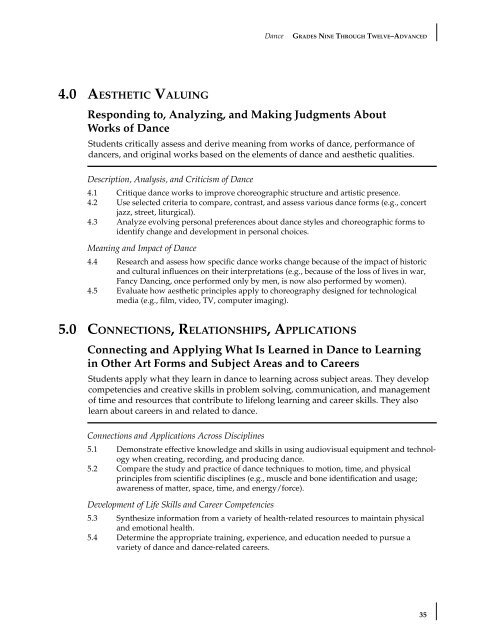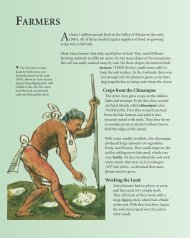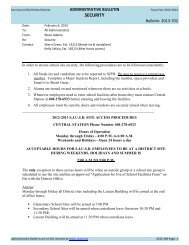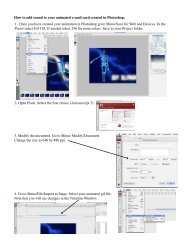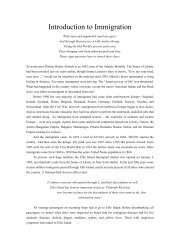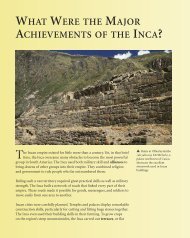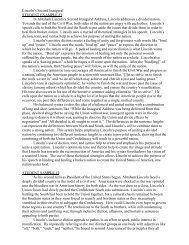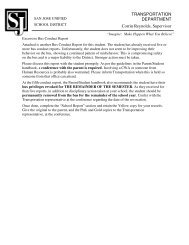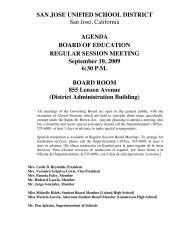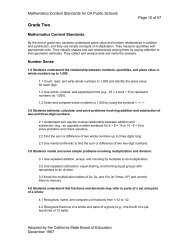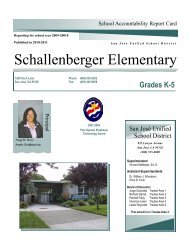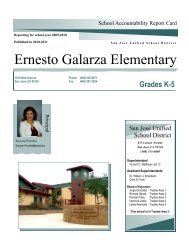Visual and Performing Arts Content Standards - California ...
Visual and Performing Arts Content Standards - California ...
Visual and Performing Arts Content Standards - California ...
Create successful ePaper yourself
Turn your PDF publications into a flip-book with our unique Google optimized e-Paper software.
Dance GRADES NINE THROUGH TWELVE–ADVANCED<br />
4.0 AESTHETIC VALUING<br />
Responding to, Analyzing, <strong>and</strong> Making Judgments About<br />
Works of Dance<br />
Students critically assess <strong>and</strong> derive meaning from works of dance, performance of<br />
dancers, <strong>and</strong> original works based on the elements of dance <strong>and</strong> aesthetic qualities.<br />
Description, Analysis, <strong>and</strong> Criticism of Dance<br />
4.1 Critique dance works to improve choreographic structure <strong>and</strong> artistic presence.<br />
4.2 Use selected criteria to compare, contrast, <strong>and</strong> assess various dance forms (e.g., concert<br />
jazz, street, liturgical).<br />
4.3 Analyze evolving personal preferences about dance styles <strong>and</strong> choreographic forms to<br />
identify change <strong>and</strong> development in personal choices.<br />
Meaning <strong>and</strong> Impact of Dance<br />
4.4 Research <strong>and</strong> assess how specific dance works change because of the impact of historic<br />
<strong>and</strong> cultural influences on their interpretations (e.g., because of the loss of lives in war,<br />
Fancy Dancing, once performed only by men, is now also performed by women).<br />
4.5 Evaluate how aesthetic principles apply to choreography designed for technological<br />
media (e.g., film, video, TV, computer imaging).<br />
5.0 CONNECTIONS, RELATIONSHIPS, APPLICATIONS<br />
Connecting <strong>and</strong> Applying What Is Learned in Dance to Learning<br />
in Other Art Forms <strong>and</strong> Subject Areas <strong>and</strong> to Careers<br />
Students apply what they learn in dance to learning across subject areas. They develop<br />
competencies <strong>and</strong> creative skills in problem solving, communication, <strong>and</strong> management<br />
of time <strong>and</strong> resources that contribute to lifelong learning <strong>and</strong> career skills. They also<br />
learn about careers in <strong>and</strong> related to dance.<br />
Connections <strong>and</strong> Applications Across Disciplines<br />
5.1 Demonstrate effective knowledge <strong>and</strong> skills in using audiovisual equipment <strong>and</strong> technology<br />
when creating, recording, <strong>and</strong> producing dance.<br />
5.2 Compare the study <strong>and</strong> practice of dance techniques to motion, time, <strong>and</strong> physical<br />
principles from scientific disciplines (e.g., muscle <strong>and</strong> bone identification <strong>and</strong> usage;<br />
awareness of matter, space, time, <strong>and</strong> energy/force).<br />
Development of Life Skills <strong>and</strong> Career Competencies<br />
5.3 Synthesize information from a variety of health-related resources to maintain physical<br />
<strong>and</strong> emotional health.<br />
5.4 Determine the appropriate training, experience, <strong>and</strong> education needed to pursue a<br />
variety of dance <strong>and</strong> dance-related careers.<br />
35


